window BMW 530I 1998 E39 Central Body Electronics ZKE Manual
[x] Cancel search | Manufacturer: BMW, Model Year: 1998, Model line: 530i, Model: BMW 530i 1998 E39Pages: 80, PDF Size: 4.14 MB
Page 34 of 80
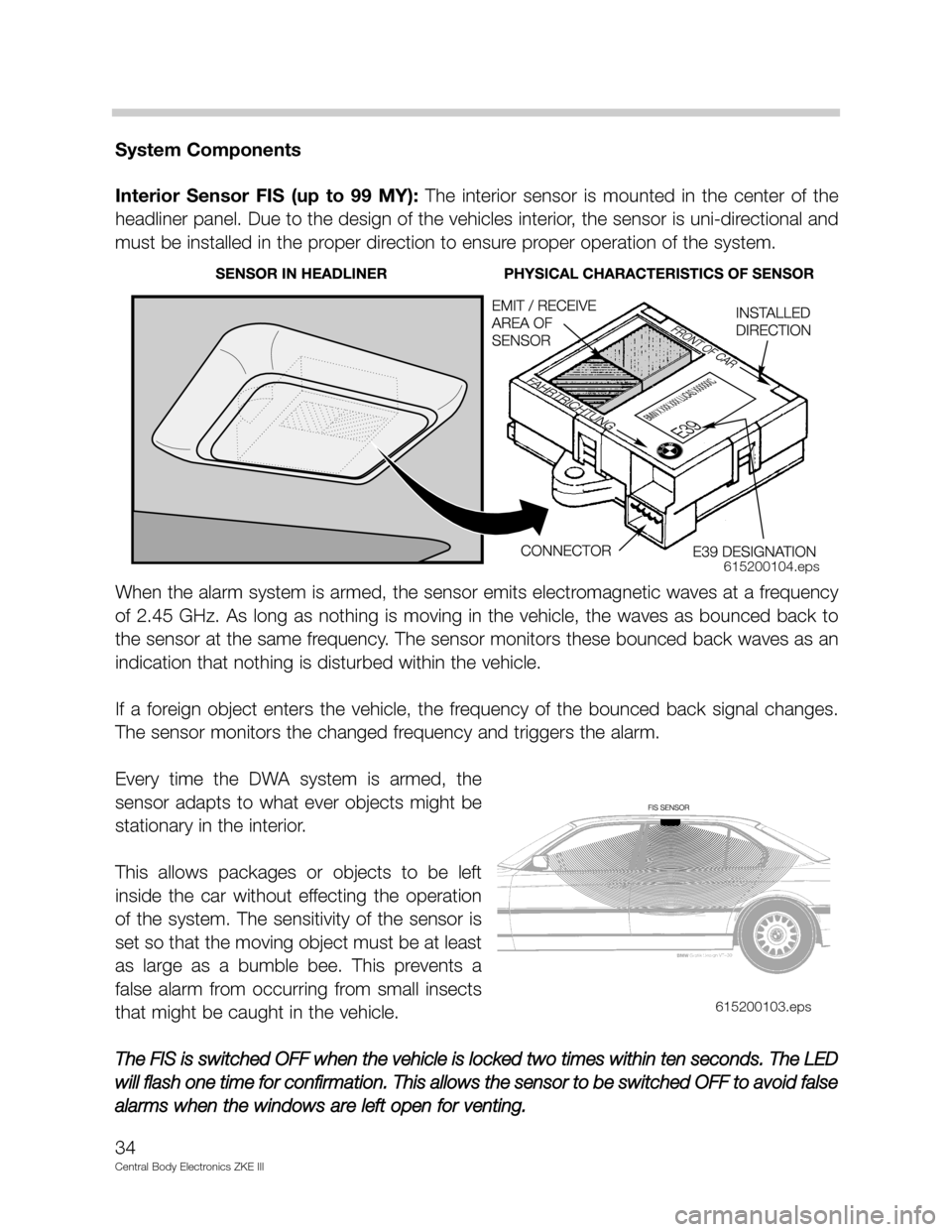
System Components
Interior Sensor FIS (up to 99 MY): The interior sensor is mounted in the center of the
headliner panel. Due to the design of the vehicles interior, the sensor is uni-directional and
must be installed in the proper direction to ensure proper operation of the system.
When the alarm system is armed, the sensor emits electromagnetic waves at a frequency
of 2.45 GHz. As long as nothing is moving in the vehicle, the waves as bounced back to
the sensor at the same frequency. The sensor monitors these bounced back waves as an
indication that nothing is disturbed within the vehicle.
If a foreign object enters the vehicle, the frequency of the bounced back signal changes.
The sensor monitors the changed frequency and triggers the alarm.
Every time the DWA system is armed, the
sensor adapts to what ever objects might be
stationary in the interior.
This allows packages or objects to be left
inside the car without effecting the operation
of the system. The sensitivity of the sensor is
set so that the moving object must be at least
as large as a bumble bee. This prevents a
false alarm from occurring from small insects
that might be caught in the vehicle.
The FIS is switched OFF when the vehicle is locked two times within ten seconds. The LED
will flash one time for confirmation. This allows the sensor to be switched OFF to avoid false
alarms when the windows are left open for venting.
34
Central Body Electronics ZKE III
615200103.eps615200104.eps
Page 35 of 80
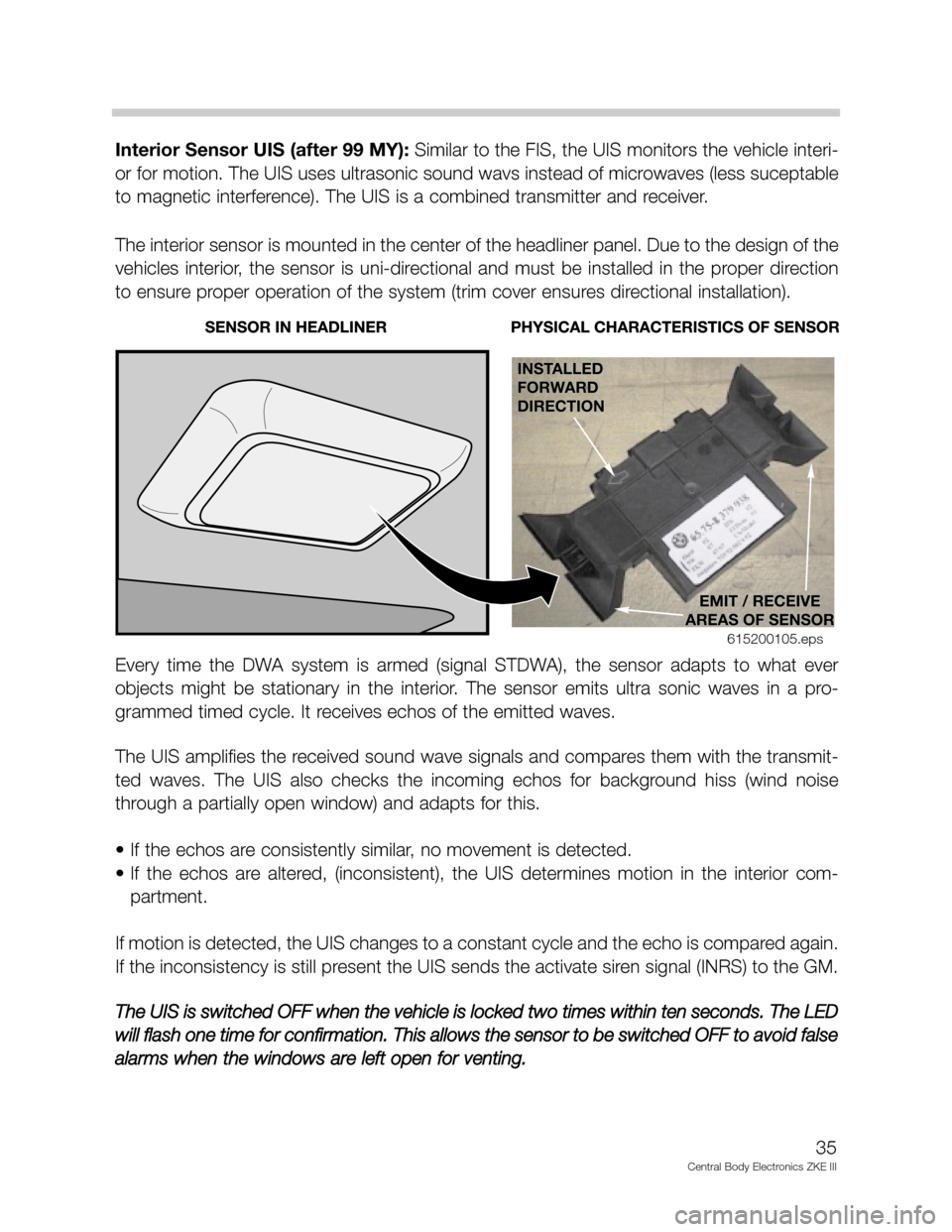
Interior Sensor UIS (after 99 MY):Similar to the FIS, the UIS monitors the vehicle interi-
or for motion. The UIS uses ultrasonic sound wavs instead of microwaves (less suceptable
to magnetic interference). The UIS is a combined transmitter and receiver.
The interior sensor is mounted in the center of the headliner panel. Due to the design of the
vehicles interior, the sensor is uni-directional and must be installed in the proper direction
to ensure proper operation of the system (trim cover ensures directional installation).
Every time the DWA system is armed (signal STDWA), the sensor adapts to what ever
objects might be stationary in the interior. The sensor emits ultra sonic waves in a pro-
grammed timed cycle. It receives echos of the emitted waves.
The UIS amplifies the received sound wave signals and compares them with the transmit-
ted waves. The UIS also checks the incoming echos for background hiss (wind noise
through a partially open window) and adapts for this.
• If the echos are consistently similar, no movement is detected.
• If the echos are altered, (inconsistent), the UIS determines motion in the interior com-
partment.
If motion is detected, the UIS changes to a constant cycle and the echo is compared again.
If the inconsistency is still present the UIS sends the activate siren signal (INRS) to the GM.
The UIS is switched OFF when the vehicle is locked two times within ten seconds. The LED
will flash one time for confirmation. This allows the sensor to be switched OFF to avoid false
alarms when the windows are left open for venting.
35
Central Body Electronics ZKE III
615200105.eps
Page 37 of 80
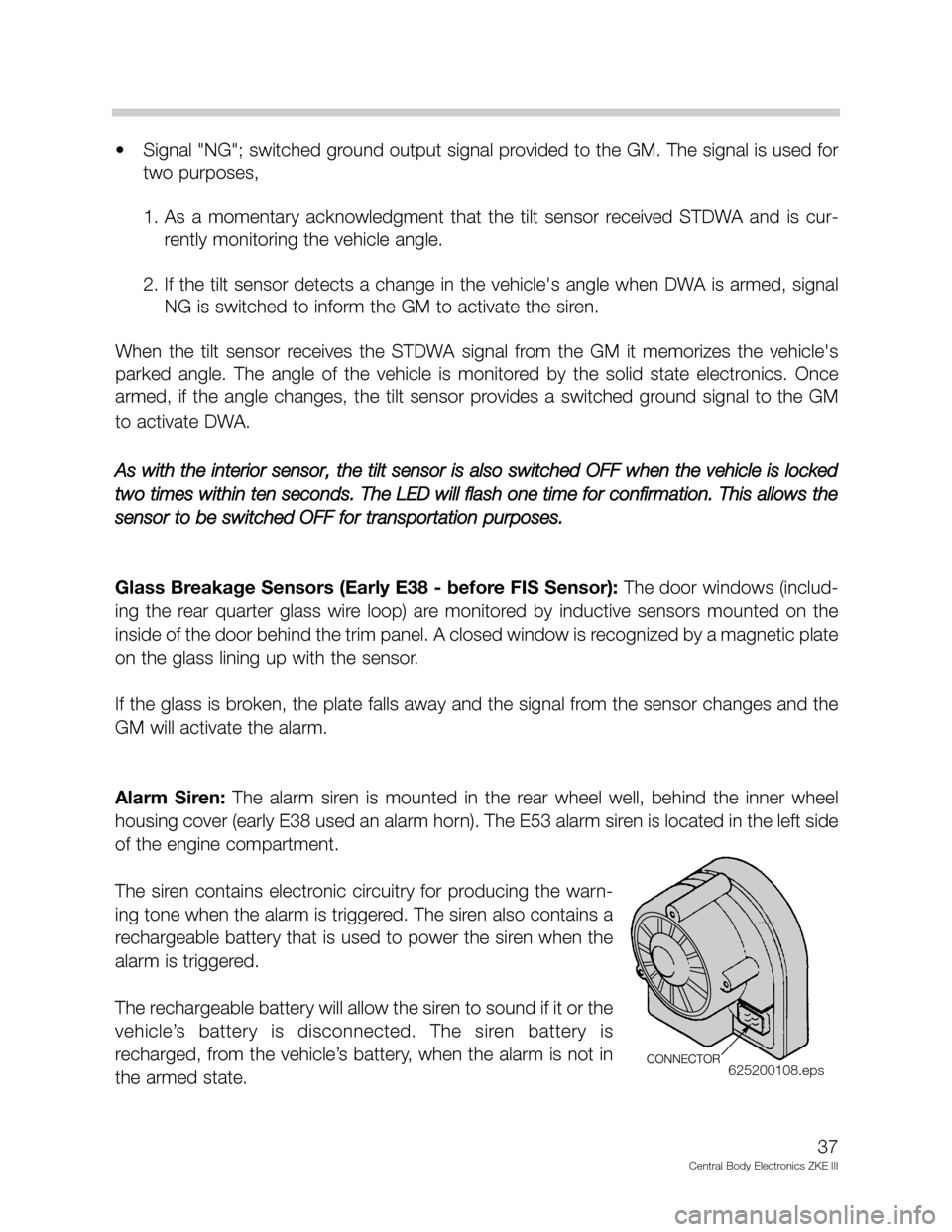
• Signal "NG"; switched ground output signal provided to the GM. The signal is used for
two purposes,
1. As a momentary acknowledgment that the tilt sensor received STDWA and is cur-
rently monitoring the vehicle angle.
2. If the tilt sensor detects a change in the vehicle's angle when DWA is armed, signal
NG is switched to inform the GM to activate the siren.
When the tilt sensor receives the STDWA signal from the GM it memorizes the vehicle's
parked angle. The angle of the vehicle is monitored by the solid state electronics. Once
armed, if the angle changes, the tilt sensor provides a switched ground signal to the GM
to activate DWA.
As with the interior sensor, the tilt sensor is also switched OFF when the vehicle is locked
two times within ten seconds. The LED will flash one time for confirmation. This allows the
sensor to be switched OFF for transportation purposes.
Glass Breakage Sensors (Early E38 - before FIS Sensor): The door windows (includ-
ing the rear quarter glass wire loop) are monitored by inductive sensors mounted on the
inside of the door behind the trim panel. A closed window is recognized by a magnetic plate
on the glass lining up with the sensor.
If the glass is broken, the plate falls away and the signal from the sensor changes and the
GM will activate the alarm.
Alarm Siren: The alarm siren is mounted in the rear wheel well, behind the inner wheel
housing cover (early E38 used an alarm horn). The E53 alarm siren is located in the left side
of the engine compartment.
The siren contains electronic circuitry for producing the warn-
ing tone when the alarm is triggered. The siren also contains a
rechargeable battery that is used to power the siren when the
alarm is triggered.
The rechargeable battery will allow the siren to sound if it or the
vehicle’s battery is disconnected. The siren battery is
recharged, from the vehicle’s battery, when the alarm is not in
the armed state.
37
Central Body Electronics ZKE III
625200108.eps
Page 42 of 80
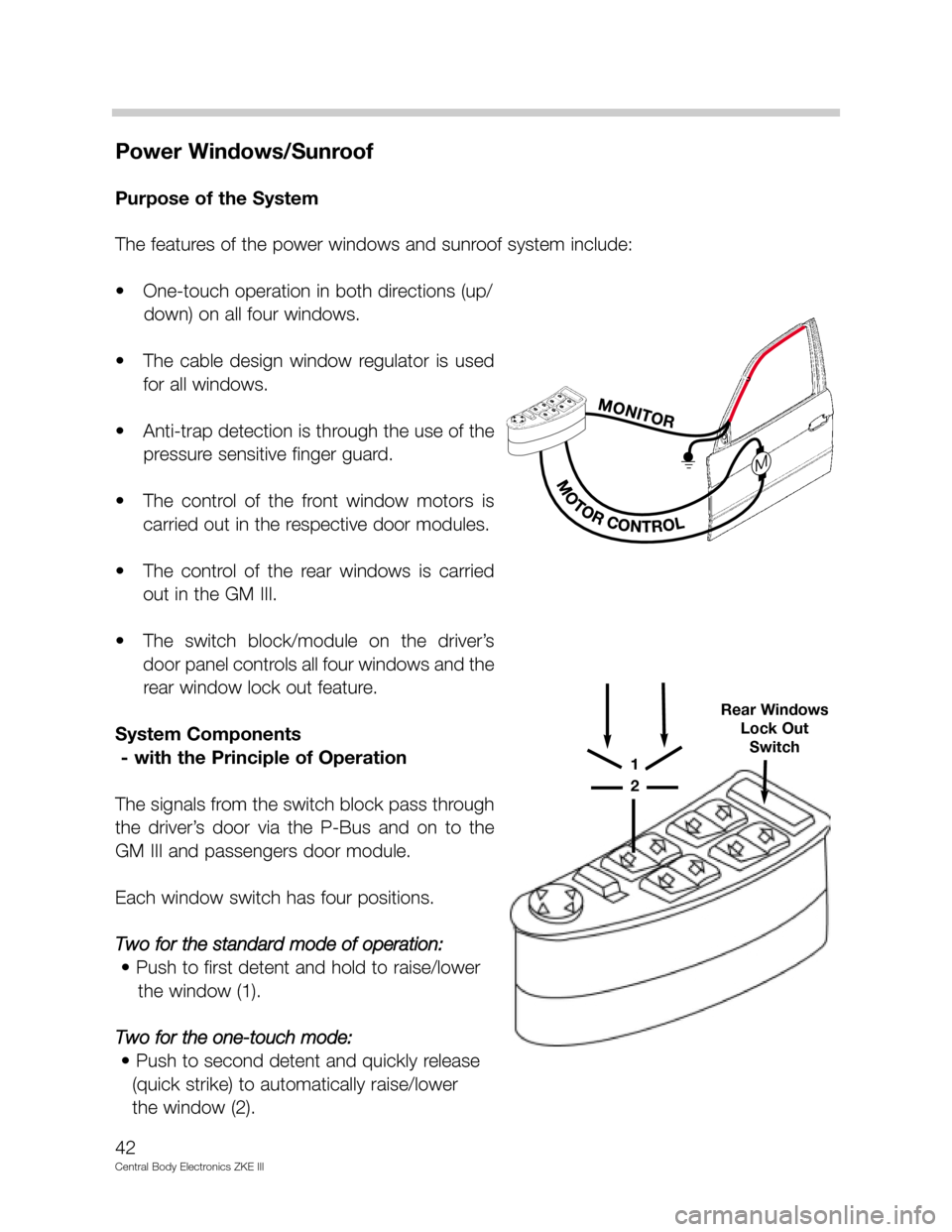
Power Windows/Sunroof
Purpose of the System
The features of the power windows and sunroof system include:
• One-touch operation in both directions (up/
down) on all four windows.
• The cable design window regulator is used
for all windows.
• Anti-trap detection is through the use of the
pressure sensitive finger guard.
• The control of the front window motors is
carried out in the respective door modules.
• The control of the rear windows is carried
out in the GM III.
• The switch block/module on the driver’s
door panel controls all four windows and the
rear window lock out feature.
System Components
- with the Principle of Operation
The signals from the switch block pass through
the driver’s door via the P-Bus and on to the
GM III and passengers door module.
Each window switch has four positions.
Two for the standard mode of operation:
• Push to first detent and hold to raise/lower
the window (1).
Two for the one-touch mode:
• Push to second detent and quickly release
(quick strike) to automatically raise/lower
the window (2).
42
Central Body Electronics ZKE III
1
2
Rear Windows
Lock Out
Switch
Page 43 of 80
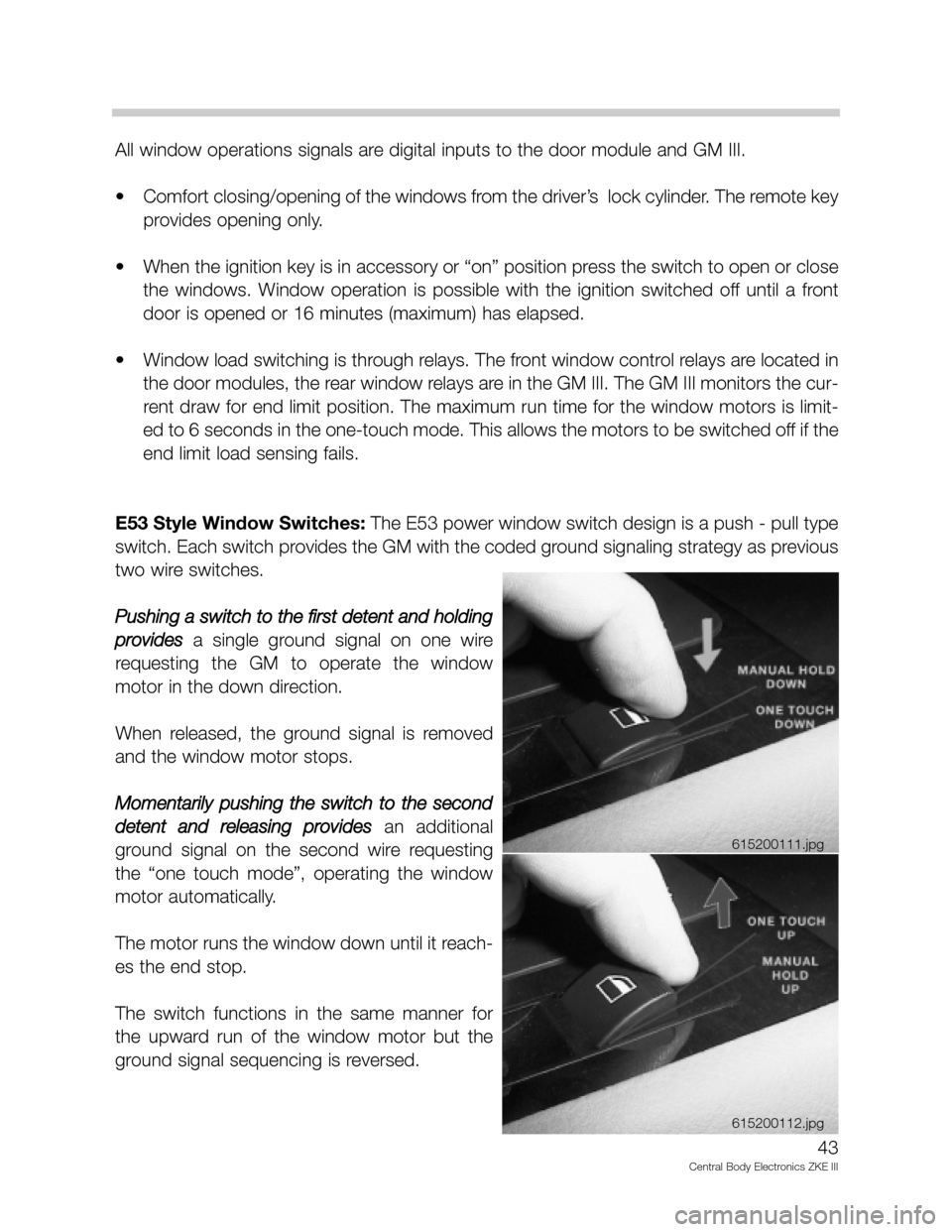
All window operations signals are digital inputs to the door module and GM III.
• Comfort closing/opening of the windows from the driver’s lock cylinder. The remote key
provides opening only.
• When the ignition key is in accessory or “on” position press the switch to open or close
the windows. Window operation is possible with the ignition switched off until a front
door is opened or 16 minutes (maximum) has elapsed.
• Window load switching is through relays. The front window control relays are located in
the door modules, the rear window relays are in the GM III. The GM III monitors the cur-
rent draw for end limit position. The maximum run time for the window motors is limit-
ed to 6 seconds in the one-touch mode. This allows the motors to be switched off if the
end limit load sensing fails.
E53 Style Window Switches:The E53 power window switch design is a push - pull type
switch. Each switch provides the GM with the coded ground signaling strategy as previous
two wire switches.
Pushing a switch to the first detent and holding
provides
a single ground signal on one wire
requesting the GM to operate the window
motor in the down direction.
When released, the ground signal is removed
and the window motor stops.
Momentarily pushing the switch to the second
detent and releasing provides
an additional
ground signal on the second wire requesting
the “one touch mode”, operating the window
motor automatically.
The motor runs the window down until it reach-
es the end stop.
The switch functions in the same manner for
the upward run of the window motor but the
ground signal sequencing is reversed.
43
Central Body Electronics ZKE III
615200111.jpg
615200112.jpg
Page 44 of 80
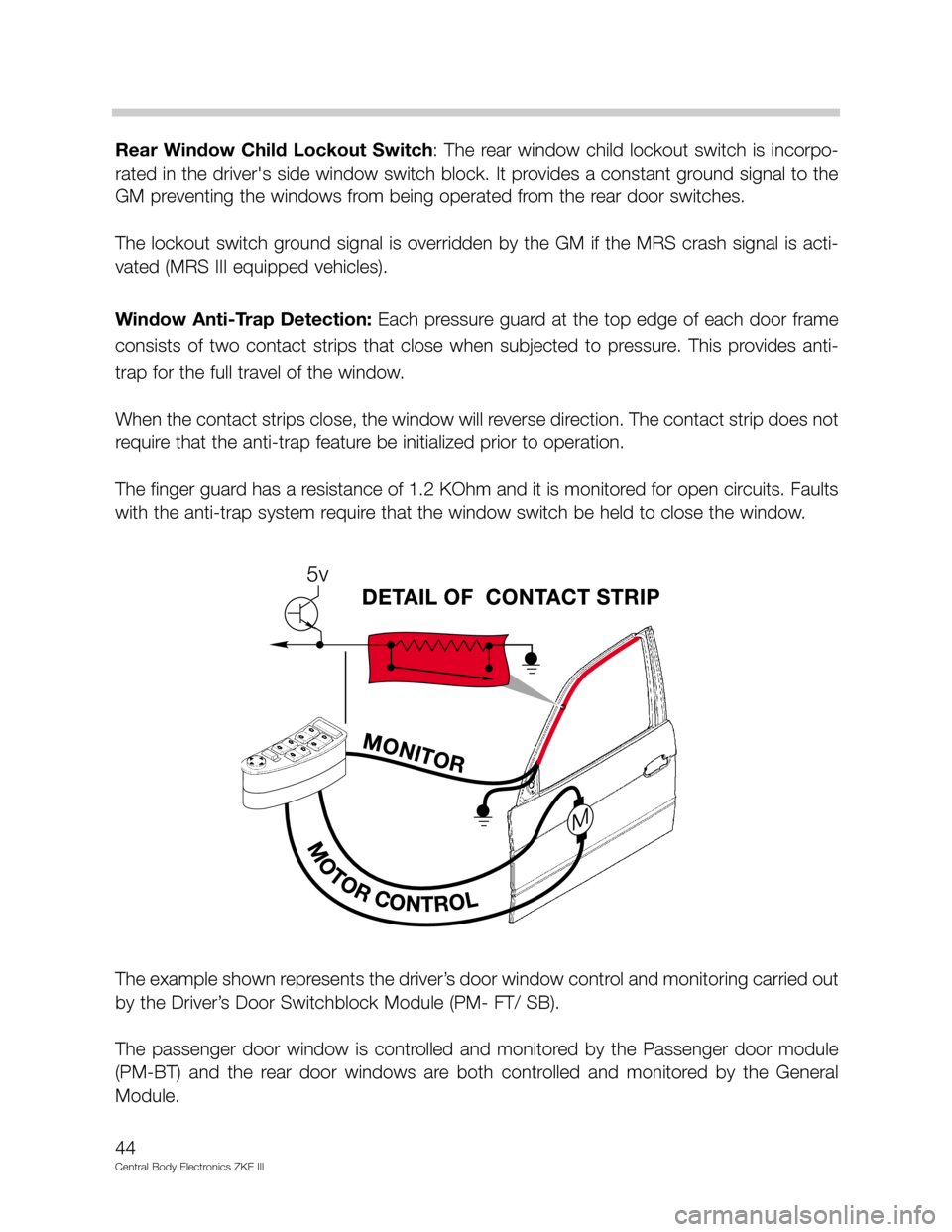
Rear Window Child Lockout Switch: The rear window child lockout switch is incorpo-
rated in the driver's side window switch block. It provides a constant ground signal to the
GM preventing the windows from being operated from the rear door switches.
The lockout switch ground signal is overridden by the GM if the MRS crash signal is acti-
vated (MRS III equipped vehicles).
Window Anti-Trap Detection: Each pressure guard at the top edge of each door frame
consists of two contact strips that close when subjected to pressure. This provides anti-
trap for the full travel of the window.
When the contact strips close, the window will reverse direction. The contact strip does not
require that the anti-trap feature be initialized prior to operation.
The finger guard has a resistance of 1.2 KOhm and it is monitored for open circuits. Faults
with the anti-trap system require that the window switch be held to close the window.
The example shown represents the driver’s door window control and monitoring carried out
by the Driver’s Door Switchblock Module (PM- FT/ SB).
The passenger door window is controlled and monitored by the Passenger door module
(PM-BT) and the rear door windows are both controlled and monitored by the General
Module.
44
Central Body Electronics ZKE III
Page 46 of 80
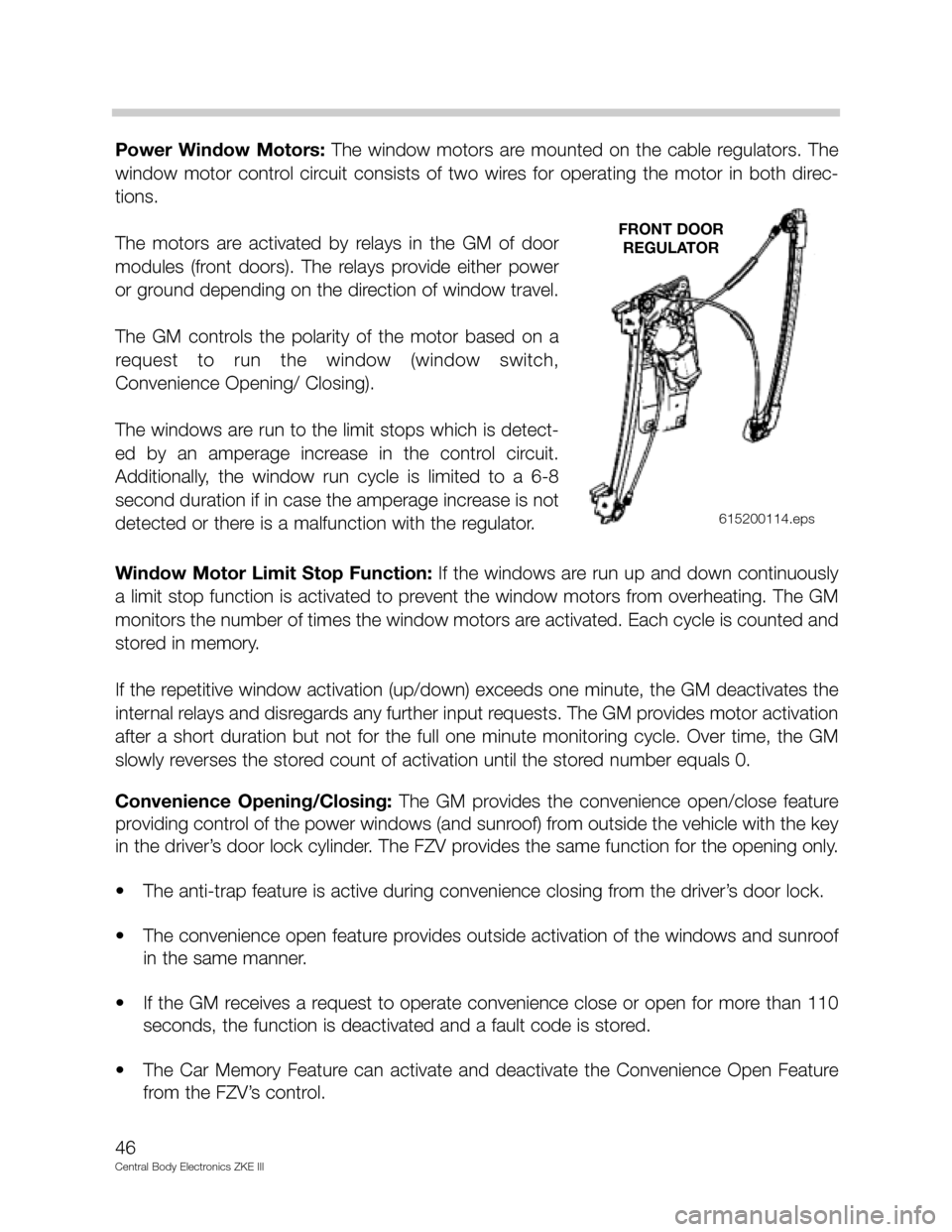
Power Window Motors: The window motors are mounted on the cable regulators. The
window motor control circuit consists of two wires for operating the motor in both direc-
tions.
The motors are activated by relays in the GM of door
modules (front doors). The relays provide either power
or ground depending on the direction of window travel.
The GM controls the polarity of the motor based on a
request to run the window (window switch,
Convenience Opening/ Closing).
The windows are run to the limit stops which is detect-
ed by an amperage increase in the control circuit.
Additionally, the window run cycle is limited to a 6-8
second duration if in case the amperage increase is not
detected or there is a malfunction with the regulator.
Window Motor Limit Stop Function: If the windows are run up and down continuously
a limit stop function is activated to prevent the window motors from overheating. The GM
monitors the number of times the window motors are activated. Each cycle is counted and
stored in memory.
If the repetitive window activation (up/down) exceeds one minute, the GM deactivates the
internal relays and disregards any further input requests. The GM provides motor activation
after a short duration but not for the full one minute monitoring cycle. Over time, the GM
slowly reverses the stored count of activation until the stored number equals 0.
Convenience Opening/Closing: The GM provides the convenience open/close feature
providing control of the power windows (and sunroof) from outside the vehicle with the key
in the driver’s door lock cylinder. The FZV provides the same function for the opening only.
• The anti-trap feature is active during convenience closing from the driver’s door lock.
• The convenience open feature provides outside activation of the windows and sunroof
in the same manner.
• If the GM receives a request to operate convenience close or open for more than 110
seconds, the function is deactivated and a fault code is stored.
• The Car Memory Feature can activate and deactivate the Convenience Open Feature
from the FZV’s control.
46
Central Body Electronics ZKE III
FRONT DOOR
REGULATOR
615200114.eps
Page 58 of 80
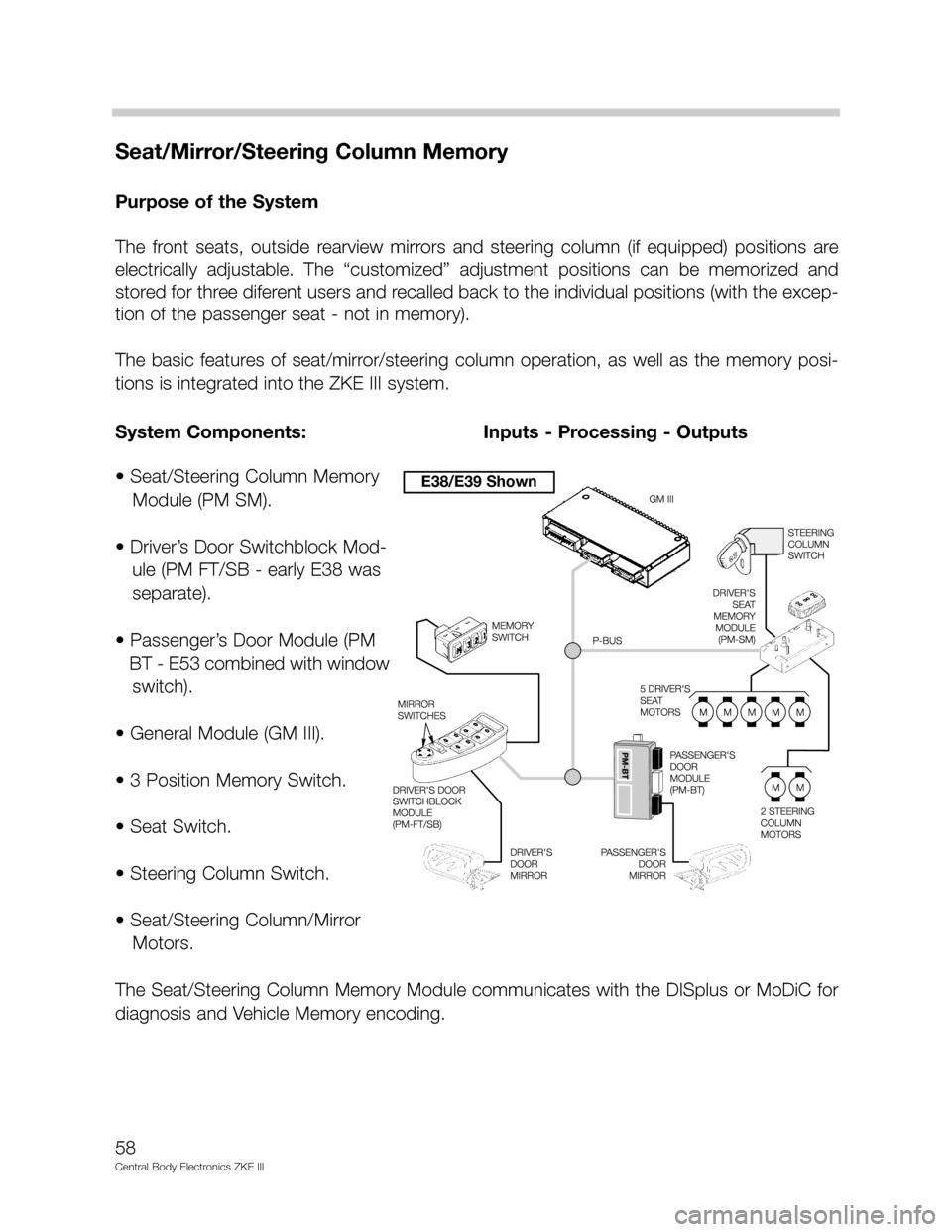
Seat/Mirror/Steering Column Memory
Purpose of the System
The front seats, outside rearview mirrors and steering column (if equipped) positions are
electrically adjustable. The “customized” adjustment positions can be memorized and
stored for three diferent users and recalled back to the individual positions (with the excep-
tion of the passenger seat - not in memory).
The basic features of seat/mirror/steering column operation, as well as the memory posi-
tions is integrated into the ZKE III system.
• Seat/Steering Column Memory
Module (PM SM).
• Driver’s Door Switchblock Mod-
ule (PM FT/SB - early E38 was
separate).
• Passenger’s Door Module (PM
BT - E53 combined with window
switch).
• General Module (GM III).
• 3 Position Memory Switch.
• Seat Switch.
• Steering Column Switch.
• Seat/Steering Column/Mirror
Motors.
The Seat/Steering Column Memory Module communicates with the DISplus or MoDiC for
diagnosis and Vehicle Memory encoding.
58
Central Body Electronics ZKE III
System Components: Inputs - Processing - Outputs
E38/E39 Shown
Page 68 of 80
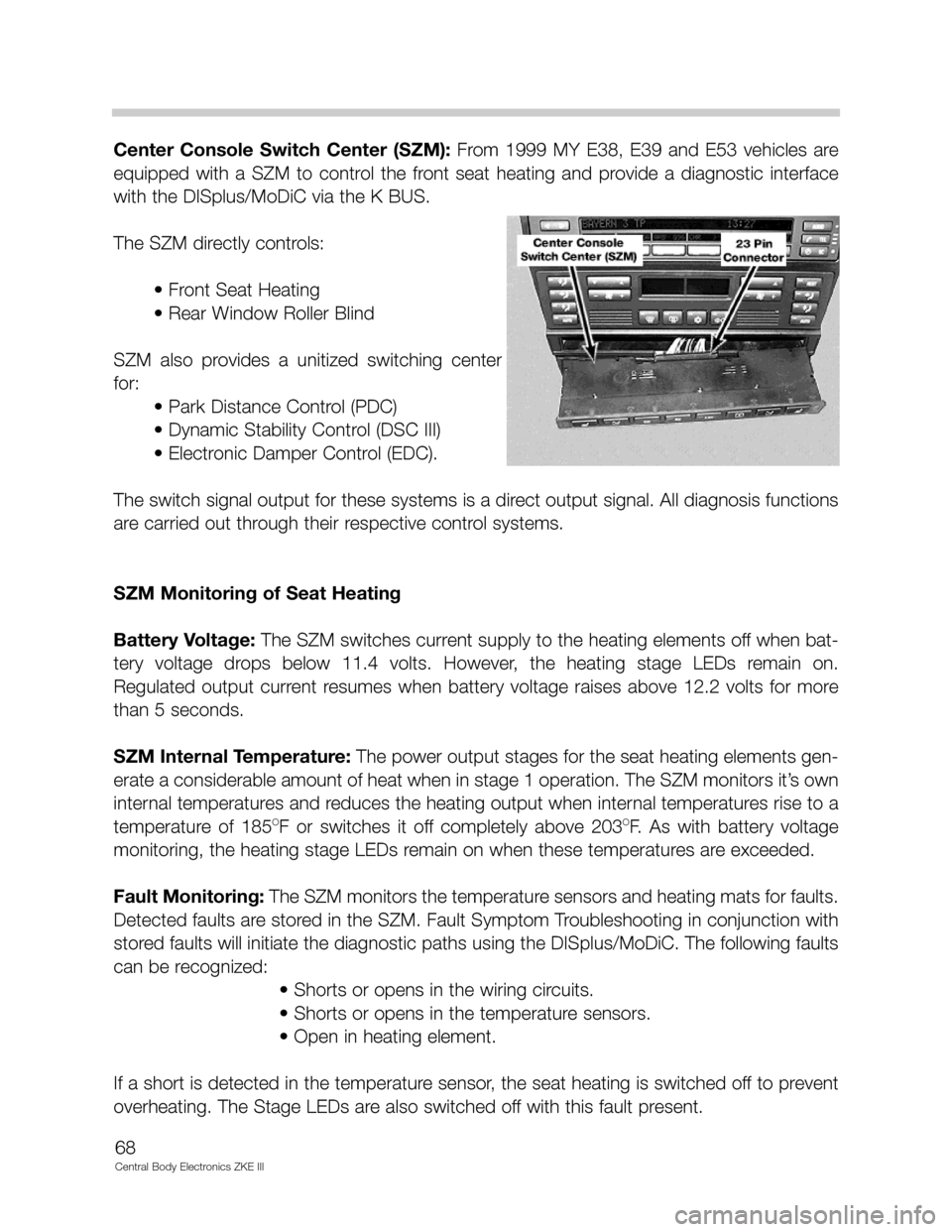
68
Central Body Electronics ZKE III
Center Console Switch Center (SZM): From 1999 MY E38, E39 and E53 vehicles are
equipped with a SZM to control the front seat heating and provide a diagnostic interface
with the DISplus/MoDiC via the K BUS.
The SZM directly controls:
• Front Seat Heating
• Rear Window Roller Blind
SZM also provides a unitized switching center
for:
• Park Distance Control (PDC)
• Dynamic Stability Control (DSC III)
• Electronic Damper Control (EDC).
The switch signal output for these systems is a direct output signal. All diagnosis functions
are carried out through their respective control systems.
SZM Monitoring of Seat Heating
Battery Voltage:The SZM switches current supply to the heating elements off when bat-
tery voltage drops below 11.4 volts. However, the heating stage LEDs remain on.
Regulated output current resumes when battery voltage raises above 12.2 volts for more
than 5 seconds.
SZM Internal Temperature: The power output stages for the seat heating elements gen-
erate a considerable amount of heat when in stage 1 operation. The SZM monitors it’s own
internal temperatures and reduces the heating output when internal temperatures rise to a
temperature of 185
OF or switches it off completely above 203OF. As with battery voltage
monitoring, the heating stage LEDs remain on when these temperatures are exceeded.
Fault Monitoring:The SZM monitors the temperature sensors and heating mats for faults.
Detected faults are stored in the SZM. Fault Symptom Troubleshooting in conjunction with
stored faults will initiate the diagnostic paths using the DISplus/MoDiC. The following faults
can be recognized:
• Shorts or opens in the wiring circuits.
• Shorts or opens in the temperature sensors.
• Open in heating element.
If a short is detected in the temperature sensor, the seat heating is switched off to prevent
overheating. The Stage LEDs are also switched off with this fault present.
Page 69 of 80
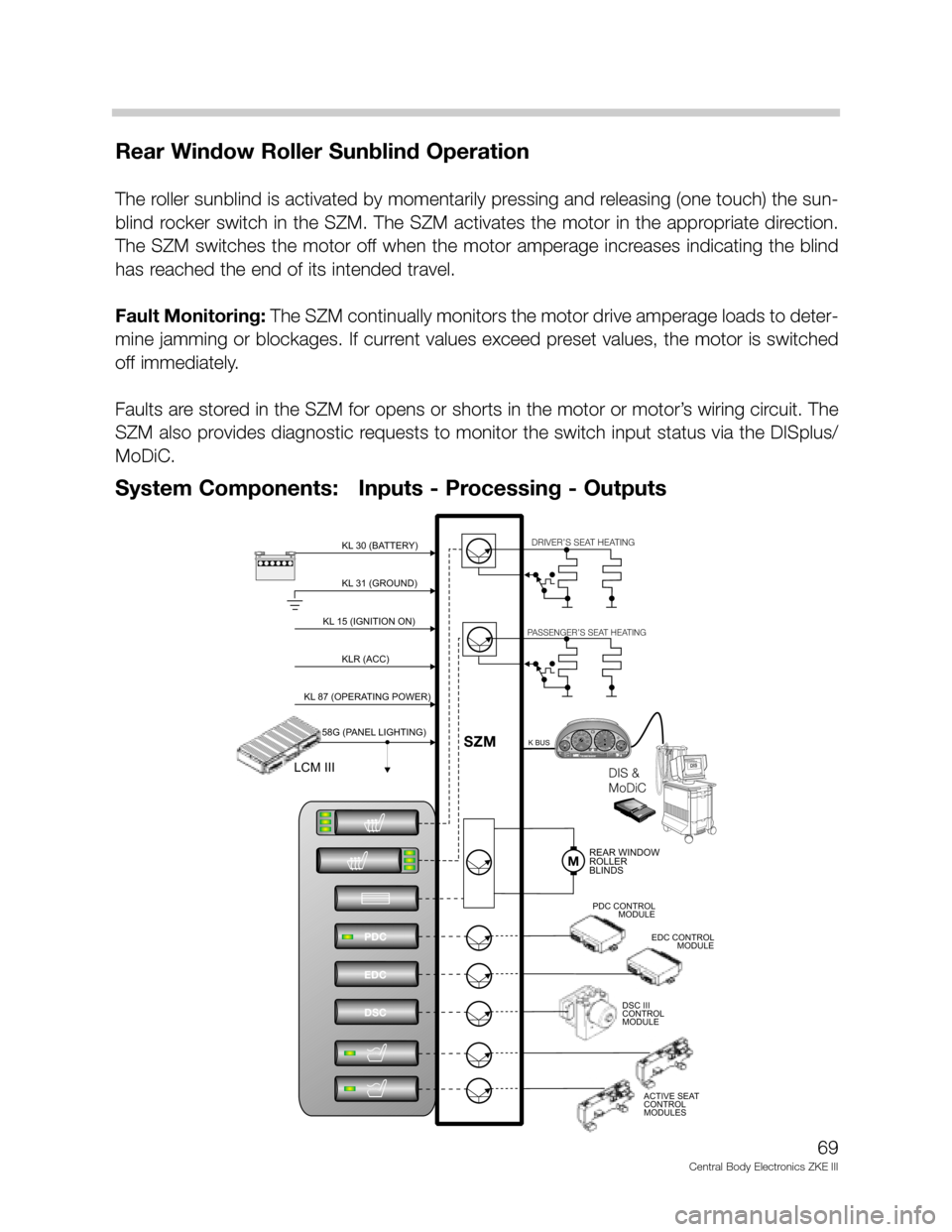
Rear Window Roller Sunblind Operation
The roller sunblind is activated by momentarily pressing and releasing (one touch) the sun-
blind rocker switch in the SZM. The SZM activates the motor in the appropriate direction.
The SZM switches the motor off when the motor amperage increases indicating the blind
has reached the end of its intended travel.
Fault Monitoring: The SZM continually monitors the motor drive amperage loads to deter-
mine jamming or blockages. If current values exceed preset values, the motor is switched
off immediately.
Faults are stored in the SZM for opens or shorts in the motor or motor’s wiring circuit. The
SZM also provides diagnostic requests to monitor the switch input status via the DISplus/
MoDiC.
69
Central Body Electronics ZKE III
KL 31 (GROUND)KL 31 (GROUND)
DIS
DIS
BMWDIS
B
M
WD
I
S
BMWDIS
BMW
DIS
D
ia
g
n
o
s
e
-
a
n
d
In
fo
r
m
a
ti
o
n
S
y
s
t
e
mDIS &
MoDiCDIS &
MoDiC
M
o
Di
C
0½
CHECK
ENGINE
CHECK
ENGINEOIL SERVICEOIL SERVICEINSPECTIONINSPECTIONP
1/min
x1000km/hELECTRONICMPH1
2020404060608080100180160140 1201002001202201402400234
5
6
7!!ABS20 DIGIT READOUT20 DIGIT READOUT
123456
prnd432
m
prnd432
m
122.4 +72.0 fo
+72.0 fomiles0
10
15 20 40
KL 30 (BATTERY)KL 30 (BATTERY)-+
KL 15 (IGNITION ON)KL 15 (IGNITION ON)
KLR (ACC)KLR (ACC)
KL 87 (OPERATING POWER)KL 87 (OPERATING POWER)
58G (PANEL LIGHTING)58G (PANEL LIGHTING)
LCM IIILCM III
PDC
EDC
DSC
MREAR WINDOW
ROLLER
BLINDSREAR WINDOW
ROLLER
BLINDS
DRIVER’S SEAT HEATINGDRIVER’S SEAT HEATING
PASSENGER’S SEAT HEATINGPASSENGER’S SEAT HEATING
K BUSK BUS
PDC CONTROL
MODULEPDC CONTROL
MODULE
EDC CONTROL
MODULEEDC CONTROL
MODULE
SZMSZM
DSC III
CONTROL
MODULEDSC III
CONTROL
MODULE
ACTIVE SEAT
CONTROL
MODULESACTIVE SEAT
CONTROL
MODULES
System Components: Inputs - Processing - Outputs